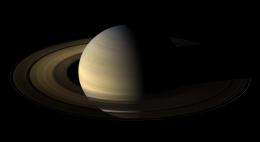Cassini Reveals New Ring Quirks, Shadows During Saturn Equinox

(PhysOrg.com) -- NASA scientists are marveling over the extent of ruffles and dust clouds revealed in the rings of Saturn during the planet's equinox last month. Scientists once thought the rings were almost completely flat, but new images reveal the heights of some newly discovered bumps in the rings are as high as the Rocky Mountains. NASA released the images Monday.
"It's like putting on 3-D glasses and seeing the third dimension for the first time," said Bob Pappalardo, Cassini project scientist at NASA's Jet Propulsion Laboratory in Pasadena, Calif. "This is among the most important events Cassini has shown us."
On Aug. 11, sunlight hit Saturn's rings exactly edge-on, performing a celestial magic trick that made them all but disappear. The spectacle occurs twice during each orbit Saturn makes around the sun, which takes approximately 10,759 Earth days, or about 29.7 Earth years. Earth experiences a similar equinox phenomenon twice a year; the autumnal equinox will occur Sept. 22, when the sun will shine directly over Earth's equator.
For about a week, scientists used the Cassini orbiter to look at puffy parts of Saturn's rings caught in white glare from the low-angle lighting. Scientists have known about vertical clumps sticking out of the rings in a handful of places, but they could not directly measure the height and breadth of the undulations and ridges until Saturn's equinox revealed their shadows.
"The biggest surprise was to see so many places of vertical relief above and below the otherwise paper-thin rings," said Linda Spilker, deputy project scientist at JPL. "To understand what we are seeing will take more time, but the images and data will help develop a more complete understanding of how old the rings might be and how they are evolving."
The chunks of ice that make up the main rings spread out 140,000 kilometers (85,000 miles) from the center of Saturn, but they had been thought to be only around 10 meters (30 feet) thick in the main rings, known as A, B, C, and D.
In the new images, particles seemed to pile up in vertical formations in each of the rings. Rippling corrugations -- previously seen by Cassini to extend approximately 804 kilometers (500 miles) in the innermost D ring -- appear to undulate out to a total of 17,000 kilometers (11,000 miles) through the neighboring C ring to the B ring.
The heights of some of the newly discovered bumps are comparable to the elevations of the Rocky Mountains. One ridge of icy ring particles, whipped up by the gravitational pull of Saturn's moon Daphnis as it travels through the plane of the rings, looms as high as about 4 kilometers (2.5 miles). It is the tallest vertical wall seen within the rings.
"We thought the plane of the rings was no taller than two stories of a modern-day building and instead we've come across walls more than 2 miles [3 kilometers] high," said Carolyn Porco, Cassini imaging team leader at the Space Science Institute in Boulder, Colo. "Isn't that the most outrageous thing you could imagine? It truly is like something out of science fiction."
Scientists also were intrigued by bright streaks in two different rings that appear to be clouds of dust kicked up in collisions between small space debris and ring particles. Understanding the rate and locations of impacts will help build better models of contamination and erosion in the rings and refine estimates of their age. The collision clouds were easier to see under the low-lighting conditions of equinox than under normal lighting conditions.
At the same time Cassini was snapping visible-light photographs of Saturn's rings, the Composite Infrared Spectrometer instrument was taking the rings' temperatures. During equinox, the rings cooled to the lowest temperature ever recorded. The A ring dropped down to a frosty 43 Kelvin (382 degrees below zero Fahrenheit). Studying ring temperatures at equinox will help scientists better understand the sizes and other characteristics of the ring particles.
The Cassini spacecraft has been observing Saturn, its moons and rings since it entered the planet's orbit in 2004. The spacecraft's instruments have discovered new rings and moons and have improved our understanding of Saturn's ring system.
Provided by JPL/NASA (news : web)



















